What are Pacific Lamprey?
The Central Coast is home to some of Cailfornia’s most incredible native species. Today we’re going to take a closer look at the Pacific lamprey.
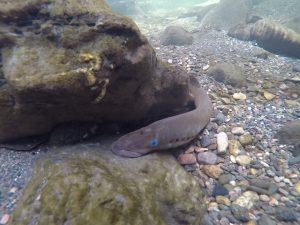
Pacific lampreys are an ancient anadromous fish that divide their lifecycle between fresh and marine waters. These eel-looking creatures (Entosphenus tridentatus) lack the jaw and paired fins that most fish have. Starting their life cycle in nests burrowed into creek bottoms, Pacific lamprey spend roughly five to seven years in their larval life stage (known as ammocoetes). Next, they emerge from the creek bed, develop eyes, and transform into non-filter feeding juvenile fish (known as macropthalmia) before migrating out to the ocean. After spending one to three years in the marine environment, the adults, which can reach up to two-and-a-half feet in length, travel back into freshwater systems for two years to spawn and eventually die.
The following videos show two pacific lamprey moving rocks, mostly likely building a nest for their young. Doug and Melia, Corpsmembers from the AmeriCorps Watershed Stewards Program in 2018 to 2019, took these videos in SLO Creek at Mission Plaza.
Benefits to the Environment
These unique fish actually help clean the waters where they reside. While juvenile and adult lamprey have round, sucker-like mouths and three large front teeth to prey on fish, young lamprey are filter feeders. This means that they pump water over their gills to filter out microscopic food particles from the water. In addition, they filter such large volumes that they can actually reduce the amount of harmful bacteria in the water.
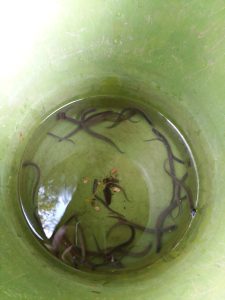
The discovery of Pacific lamprey in SLO County creeks was thrilling to local biologists. According to the U.S. Fish and Wildlife Service (USFWS), Pacific lamprey have historically inhabited anadromous drainages in Hokkaido Island, Japan and around the Pacific Rim including Alaska, Canada, Washington, Oregon, Idaho, and California down to Baja. They are thought to live in the types of waterways that also support salmon and steelhead. USFWS monitoring indicates that lamprey have been seen intermittently in SLO County creeks, with their presence officially confirmed in 2017. Habitat degradation from human activity is a likely contributor to their significantly reduced numbers.
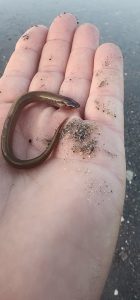
The confirmation of lamprey presence in the County led to further monitoring of the species. Local biologist Parker Kalen collaborated with the City of San Luis Obispo, the California Department of Fish and Wildlife, and the Pacific Lamprey Conservation Initiative to conduct a research project in 2019 to investigate lamprey larvae capacity to remove bacteria such as E. coli from the water through their filter feeding. Parker, along with City of SLO biologist Freddy Otte, Tenera Environmental, and Cal Poly, spearheaded this research and a published paper.
Effectively the laboratory study showed a faster rate of E.coli reduction in tanks that had presence of Pacific lamprey ammoceoetes. Additionally, this effect was more pronounced with more ammoceoets, suggesting that they are in fact playing a role in promoting clean water quality. This study was unique in that it was the first formal evidence of this ecosystem service that Pacific lamprey could provide (Kalan et al. 2023).
Tracking Pacific lamprey in SLO County
While the research team recently conducted eDNA (environmental DNA) testing to confirm Pacific lamprey presence in SLO Creek and other streams on the Central Coast, the Estuary Program conducted testing to see if the fish reside in the Morro Bay watershed. Water samples from Warden and Chorro Creeks were filtered and sent to a lab for DNA testing this past June. All samples tested negative for the presence of Pacific lamprey. However, this was just one round of monitoring, so their presence should not be definitively ruled out. Future testing will be conducted. With the presence of lamprey confirmed in the surrounding drainages, there’s a good chance that the creeks in the Morro Bay watershed could serve as lamprey habitat in the future.
Additionally, Parker with Tenera Environmental conducted eDNA surveys at several watersheds throughout SLO County. These surveys indicated Pacific lamprey presence at San Carpoforo, Arroyo De La Cruz, and San Luis Obispo Creeks. These results suggest that Pacific lamprey use several watersheds in our county. They also suggest that future study, including continued eDNA surveys, would be merited.
City of SLO Restoration Efforts
The City of SLO has efforts underway to support the Pacific lamprey population in our area. Freddy explained that waterfalls, dams, weirs, and other barriers in the creeks must be addressed so that Pacific lamprey can make the trip from the Pacific Ocean and up SLO Creek to spawn. In 2013, a weir in San Luis Obispo Creek was modified to help lamprey get past this barrier to their migration. This weir is visible from the Bob Jones trail. The city installed a low tech and affordable fix nicknamed the “LampRamp.” It consists of a bent metal sheet placed along the weir. The surface is at a less steep angle that makes it easier for lamprey to get over the weir and continue their way upstream.
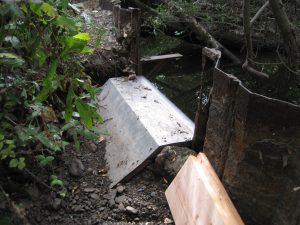
An additional project, brainstormed and executed by the City of SLO and other partners, was to install a plastic tube next to the LampRamp. This tube can track motion, record a time stamp, and capture an image as Pacific lamprey moved through it. Other projects to improve access for lamprey are underway.
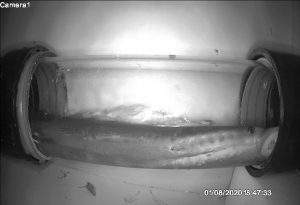
What Can You Do?
While more research and restoration are needed, everyone has a chance to help these amazing creatures succeed. Supporting our Pacific lamprey not only benefits water quality but also helps protect a species that carries a large cultural value to indigenous peoples. In addition, keeping our local waterways free of hazards and adopting a “leave no trace” attitude helps to support Pacific lamprey and all the other amazing creatures living in our area.
References
Video: P. Lamprey spawning in SLO Creek. Video by Doug and Melia, AmeriCorps Watershed Stewards Program members.
Pacific Lamprey Conservation Initiative | Collaborative conservation of Pacific Lamprey
Pacific Lamprey (Entosphenus tridentatus) | U.S. Fish & Wildlife Service (fws.gov)
Ecosystem Services: Definition, Examples and a Simple Explanation (scienceabc.com)
Environmental DNA (eDNA) | U.S. Geological Survey (usgs.gov)
Help us protect and restore the Morro Bay estuary!
- Donate to the Estuary Program today and support our work in the field, the lab, and beyond.
The Estuary Program is a 501(c)3 nonprofit. We depend on funding from grants and generous donors to continue our work. - Support us by purchasing estuary-themed gear from ESTERO. This locally owned and operated company donates 20% of proceeds from its Estuary clothing line and 100% of Estuary decal proceeds to the Estuary Program. Thank you, ESTERO!
- Purchase items from the Estuary Program’s store on Zazzle. Zazzle prints and ships your items, and the Estuary Program receives 10% of the proceeds. Choose from mugs, hats, t-shirts, and even fanny packs (they’re back!) with our fun Estuary Octopus design, our classic Estuary Program logo, or our Mutts for the Bay logo.
- We want to hear from you! Please take a few minutes to fill out this short survey about what type of events you’d like to see from the Estuary Program. We appreciate your input!